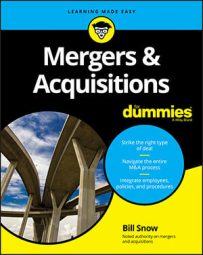A company thinking about making acquisitions just doesn’t wake up one day and close a deal. Successfully undertaking M&A activity takes some planning and preparation.
Determine the appropriate type of acquisition
How much revenue does the target need to have? Does the target need to have a minimum profitability level, and if so, what is it? Are you willing to consider acquiring a money-losing operation? Should the acquired company be a product extension or a new product? Should the acquisition allow you to vertically integrate? These are only a few of the possible questions to consider when choosing a potential acquisition.
Unless you have a clear idea of what you want to buy, you probably won’t successfully close a deal. Many strategic and financial Buyers often take a “show me everything” approach when looking for acquisitions. The odds of finding the right fit are exceedingly low when you haven’t defined the parameters of a right fit.
Get your company’s balance sheet in order
How’s your balance sheet? No, really, be honest. How is it? If your balance sheet is a mess, your company isn’t ready to do deals. Companies able to successfully do deals have strong cash positions and little or no debt. Working capital should be positive, and the current ratio should be at or above the industry norm.
Have the money lined up
Have your sources of cash ready to go before you begin the acquisition process. Sure, a strong balance sheet with lots of cash is very helpful, but an acquirer doesn’t necessarily have to use its own money to fund 100 percent of a deal.
Depending on the acquirer’s situation, a line of credit from a bank, a mezzanine fund (a lender subordinate to the bank loan), and/or a private equity fund may be able to help with the financing.
Although you don’t have to have a private equity fund or mezzanine fund as a financial partner to make an acquisition, failure to line up your sources of financing ahead of time may mean you’re unable to close a deal, resulting in wasted time for both you and Seller. Also, reputations travel because people talk. A Buyer unable to close a deal because of a lack of forethought sullies its reputation.
Set up an acquisition chain of command
In order to successfully complete acquisitions, you need to determine who’s taking what role. If you’re handling the acquisition internally, give team members specific jobs: compiling the target list, making the calls, negotiating and structuring the deals, and so on.
If you’re bringing in an outside firm to perform some or all of these tasks, appoint an internal person to be the main interface with the intermediary. Following this chain of command at all times helps the acquisition process go smoothly and efficiently by eliminating poor communication and duplicate steps.
Designate a specific individual as the deal point-person to have all of the interaction with Seller or Seller’s representative. All requests and questions go through this one person to prevent poor communication, duplicated steps, and a frustrated Seller.

